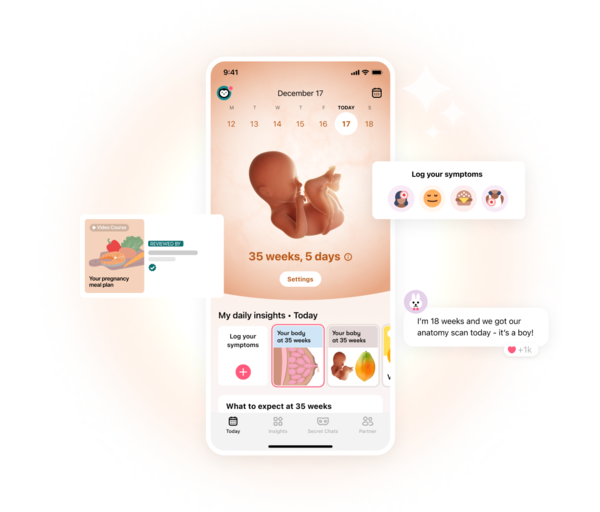Being pregnant with quadruplets is an extremely exciting experience, but it’s also perfectly normal to feel a bit anxious. Quadruplets are very rare and can present some unique challenges. Read on for Flo’s take on what to do when you’re pregnant with quadruplets.
-
Tracking cycle
-
Getting pregnant
-
Pregnancy
-
Help Center
-
Flo for Partners
-
Anonymous Mode
-
Flo app reviews
-
Flo Premium New
-
Secret Chats New
-
Symptom Checker New
-
Your cycle
-
Health 360°
-
Getting pregnant
-
Pregnancy
-
Being a mom
-
LGBTQ+
-
Quizzes
-
Ovulation calculator
-
hCG calculator
-
Pregnancy test calculator
-
Menstrual cycle calculator
-
Period calculator
-
Implantation calculator
-
Pregnancy weeks to months calculator
-
Pregnancy due date calculator
-
IVF and FET due date calculator
-
Due date calculator by ultrasound
-
Medical Affairs
-
Science & Research
-
Pass It On Project New
-
Privacy Portal
-
Press Center
-
Flo Accuracy
-
Careers
-
Contact Us
What to Expect When You’re Pregnant with Quadruplets


Every piece of content at Flo Health adheres to the highest editorial standards for language, style, and medical accuracy. To learn what we do to deliver the best health and lifestyle insights to you, check out our content review principles.
Overview of being pregnant with quadruplets
A multiple pregnancy is when you carry more than one fetus in your uterus at a time. While it’s certainly possible to become pregnant with quadruplets the natural way, it happens far more often during fertility treatments.
Fertility medications that encourage ovulation could trigger the release of several eggs from your ovaries. Plus, the emergence of advanced reproductive technologies (ART), including in vitro fertilization (IVF), has upped the rate of multiple pregnancies. However, doctors have started to limit the number of embryos transferred in order to prevent complications associated with multiple pregnancies.
On the other hand, Mother Nature has her own way of helping you become pregnant with quadruplets. If your ovary releases more than one mature egg during a menstrual cycle (all of which are fertilized by sperm), it results in multiple embryos. This phenomenon produces fraternal twins, triplets, etc. By contrast, the formation of multiple, identical embryos happens when a single fertilized egg breaks or splits. Identical siblings are usually twins since identical triplets and identical quadruplets are incredibly rare.
It’s also possible for a multiple pregnancy to include both identical and fraternal embryos. For example, you could get pregnant with quadruplets and carry a set of identical twins and a set of fraternal twins at the same time!
Causes of a multiple pregnancy
Although it’s possible for anyone to experience a multiple pregnancy, there are certain factors that stack the odds in its favor, including:
- Genetics
If your family has a history of multiple pregnancies, you’re likelier to give birth to twins, triplets, quadruplets, etc.
- Age
Women over the age of 30 occasionally release more than one egg during their menstrual cycle, boosting their chances of becoming pregnant with quadruplets.
- Previous pregnancies
Already had a multiple pregnancy? Then you’ll always be prone to carrying more than one bun in your oven at a time!
- Ethnicity
Ethnic background plays a role as well. For instance, research shows that African-American women exhibit a tendency towards multiple pregnancies, whereas Asian and Native American women demonstrate the opposite.
- Using assisted reproductive technology
ART treatments, especially those involving ovulation-inducing medications, could aid you in becoming pregnant with quadruplets.
Tips for when you’re pregnant with quadruplets
A balanced lifestyle is vital to the health and wellness of both you and your children. If you have any questions about being pregnant with quadruplets or about labor and delivery, please consult your doctor.
Take a quiz
Find out what you can do with our Health Assistant
Eating

If you’re pregnant with quadruplets, you’ll require an extra 300 calories per day for each fetus, in addition to your own usual caloric intake. But your doctor might recommend a lesser or greater amount based on your unique circumstances.
Note that a multiple pregnancy means you have an increased chance of developing anemia. That’s why it’s critical to get your recommended daily allowance of folic acid and iron to promote healthy fetal development under your doctor’s recommendations. These can be found in prenatal supplements and fortified foods.
Sleeping
The majority of women experience sleep discomfort with a multiple pregnancy. You may be struggling with back pain, heartburn, breathing problems, and constipation. And if you’re pregnant with quadruplets, you’re probably noticing these issues well before your third trimester.
Try lying on your side and placing a wedge-shaped pregnancy pillow between your legs and/or under your baby bump while you’re pregnant with quadruplets.
Complications of being pregnant with quadruplets
Some of the difficulties commonly associated with having quadruplets or higher multiples include:
- Premature birth
Many twins are born around week 36 of pregnancy, and quadruplets tend to arrive even sooner than that. If you’re having a multiple pregnancy, your newborns might struggle with chronic medical issues which require them to stay in the NICU. Potential short and long-term problems include digestive and breathing disorders, infections, and impaired vision.
- Cerebral palsy
The likelihood of developing cerebral palsy is higher with preterm multiples than a single premature baby of similar gestational age.
- Gestational diabetes
When you’re pregnant with quadruplets, you may be at greater risk for gestational diabetes or elevated blood sugar levels. Enlist the help of a registered dietitian, diabetes educator, or endocrinologist to properly manage your glucose levels.
- High blood pressure
A multiple pregnancy may also make you more susceptible to eclampsia and preeclampsia ‒ a medical condition characterized by high blood pressure and related symptoms.
- C-section delivery
When it comes to quadruplets and higher multiples, a C-section is the method of choice to help ensure your safety as well as your babies’ safety.
- Low birth weight
Quadruplets and other multiples tend to weigh less at birth and grow more slowly than single newborns. It’s caused by numerous factors, including placental and umbilical cord problems.
Since being pregnant with quadruplets can be so much more complex, you may need to see your obstetrician-gynecologist for frequent prenatal visits. Starting in the second trimester, you’ll probably require ultrasounds every four to six weeks.
Lastly, remember to take good care of yourself. Being a new mom is tough, especially if you’re caring for more than one baby. Multiple pregnancies also carry a great deal of stress, anxiety, and an increased likelihood of depression. Seek support from loved ones and don’t be afraid to talk about your feelings if you notice signs of postpartum depression.
Takeaway
Congratulations, you’ve just found out that you’re pregnant four times over! It’s a thrilling prospect but also a slightly scary one. Secure some peace of mind by learning more about the challenges of having quadruplets. Also, be sure to attend all your scheduled prenatal appointments, maintain a healthy lifestyle, and get as much support as you can to prepare for the arrival of your babies!


Hey, I'm Anique
I started using Flo app to track my period and ovulation because we wanted to have a baby.


The Flo app helped me learn about my body and spot ovulation signs during our conception journey.


I vividly
remember the day
that we switched
Flo into
Pregnancy Mode — it was
such a special
moment.
Real stories, real results
Learn how the Flo app became an amazing cheerleader for us on our conception journey.
References
History of updates
Current version (16 March 2020)
Published (16 March 2020)
In this article

Get your personal guide to pregnancy with the Flo app
-
Follow your baby's growth week by week
-
Get expert info on symptoms, safe foods, and more
-
Chat with other parents-to-be




